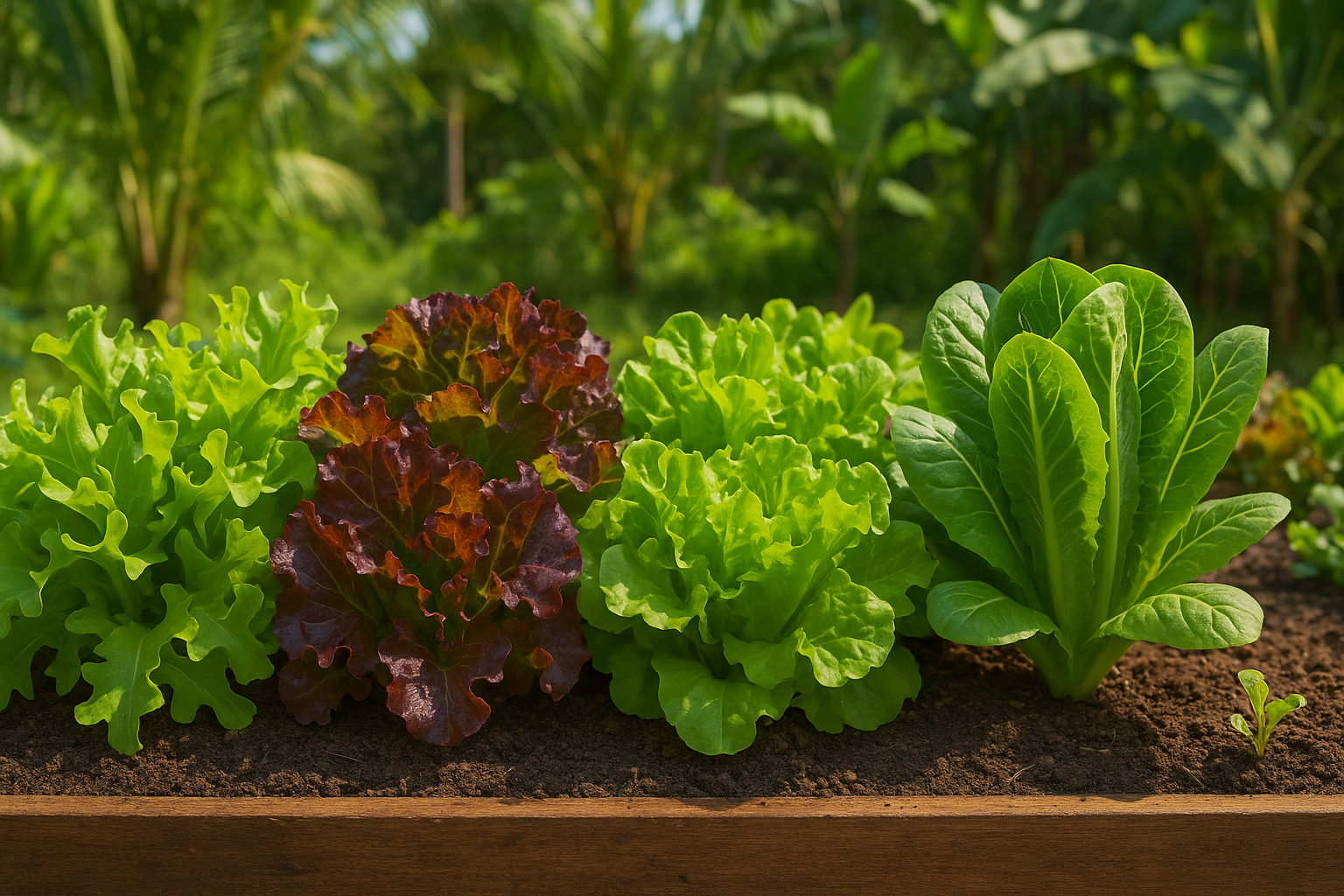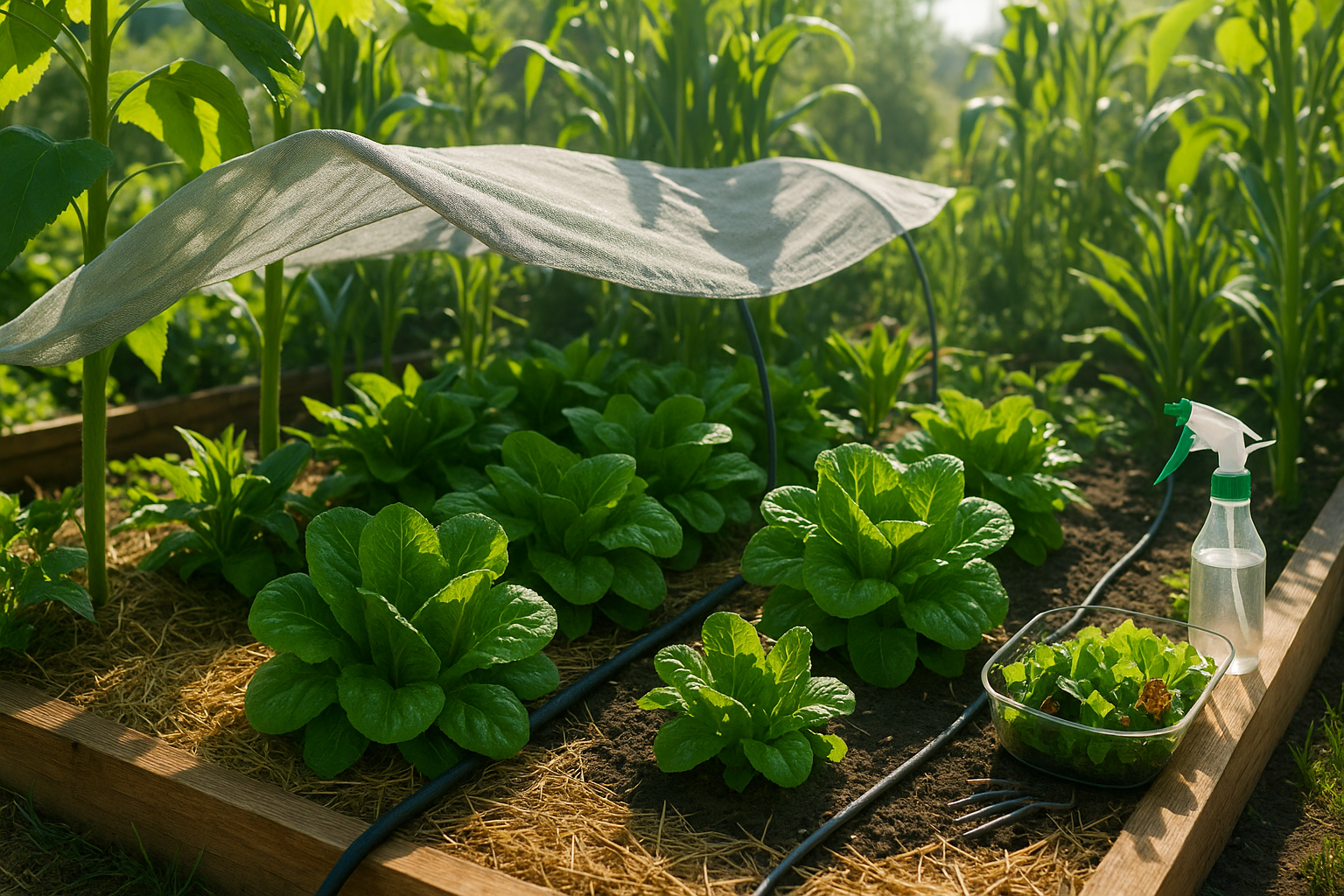Introduction
If you’ve ever tried growing lettuce in the tropics, you know that this leafy green isn’t always a fan of sun-soaked, humid weather. Lettuce naturally thrives in cooler climates, so in regions with relentless heat, plants often bolt quickly and develop bitter leaves before you get a chance to enjoy a harvest.
For anyone living in the tropics, this can be frustrating—yet lettuce is a staple in salads and sandwiches, and being able to grow your own means fresh, crisp greens whenever you want, right from your garden. Fortunately, while the challenges are real, they aren’t impossible to overcome. Many gardeners in tropical regions successfully cultivate delicious lettuce by adapting their approach.
In this post, we’ll explore why lettuce struggles in hot environments and discuss smart techniques like choosing heat-tolerant varieties, adjusting watering routines, using shade cloth, and tweaking your planting schedule. Whether you’re a backyard gardener or growing on a balcony, you’ll find practical solutions to beat the heat and enjoy homegrown lettuce even under the tropical sun.
Choosing the Right Lettuce Varieties

When gardening in tropical or consistently warm climates, selecting heat-tolerant lettuce varieties is essential for a successful year-round harvest. Loose-leaf types like ‘Salad Bowl’ (both green and red), ‘Black Seeded Simpson,’ and ‘Oakleaf’ are top choices. These varieties are bred to resist bolting (going to seed too early), maintain a crisp texture, and stay flavorful even as temperatures climb.
Cos or romaine lettuces such as ‘Parris Island Cos’ and ‘Jericho’ also perform well in the heat, with ‘Jericho’ being especially noted for thriving in desert and tropical settings. Specialty types like ‘Summer Bibb’ or ‘Batavia’ lettuces (sometimes labeled as French Crisp) are popular in hot regions because they combine the tender leaves of butterheads with the heat resistance of romaine, making them a great all-purpose choice.
Compared to standard cool-climate lettuces—like iceberg or most butterheads—these varieties have a greater tolerance for temperature swings and resist turning bitter or wilting quickly.
When sourcing seeds, check reputable online seed companies, local nurseries, or agricultural cooperatives that stock varieties selected for your region. In seed descriptions, look for phrases like “slow-bolting,” “heat-tolerant,” “suitable for warm climates,” or specific notes about success in subtropical or tropical areas. Some catalogs even list recommended planting seasons by region, which helps ensure you’ll find varieties with proven performance under the tropical sun.
It also pays to ask local gardening groups or forums for tips on which varieties have worked best in your area—many home gardeners are happy to share their reliable favorites and sourcing tips. These steps will help you enjoy crisp, homegrown salads year-round, even when temperatures soar.
Tips for Sowing and Germination Success

Sowing lettuce in tropical regions requires a few strategic adjustments for the best results. Unlike cool climates, where lettuce thrives almost year-round, tropical growers should focus on the cooler, less humid months—often during the dry season or when nighttime temperatures dip below 24°C (75°F).
Early mornings or late afternoons are ideal for sowing to avoid peak daytime heat. For reliable germination in hot weather, consider pre-chilling lettuce seeds in your fridge for a day or two before planting; this can “trick” seeds into sprouting more readily.
Another simple but effective approach is to sow seeds under light shade—using shade cloth, netting, or even natural canopies from taller plants—to protect delicate seedlings from intense sunlight. Lightly covering seeds with a thin layer of moist soil or vermiculite, no deeper than 0.5 cm, helps retain moisture and shields against harsh rays.
When it comes to spacing, scatter seeds thinly; once seedlings develop their first true leaves, thin them so they stand about 20 cm (8 inches) apart. This avoids overcrowding, reduces the risk of damping-off, and allows each plant enough space and airflow for robust growth. Don’t toss the extra seedlings—use them as tender microgreens in salads!
Regularly misting the soil keeps it cool and consistently moist, essential until seedlings are well established. By combining timely sowing, light shade, protective seed covering, and careful spacing, you’ll set your lettuce up for vibrant, healthy growth even in the tropics’ challenging heat.
Managing Heat and Sun Exposure

Protecting lettuce from harsh sun and heat starts with simple yet effective shade solutions. Erecting a lightweight shade cloth—ideally with 30-50% density—over your beds can dramatically lower temperatures around your plants, acting like a sunscreen while still allowing enough light for healthy growth. If you prefer a natural approach, consider planting taller companion crops such as corn, sunflowers, or even strategically placed trellises with pole beans to cast partial shade during the hottest part of the day. Timing your planting can also help: sow lettuce in the early morning or late afternoon to avoid the worst heat, and consider spring or fall growing when sunlight is gentler.
Another essential trick is mulching. Spread a two-inch layer of clean straw, shredded leaves, or grass clippings around your lettuce to insulate roots, conserve moisture, and keep the soil cool. Dark soil absorbs and radiates more heat, so mulch acts as a barrier, reducing temperature swings and slowing evaporation. Some growers even use reflective mulches or place light cardboard between rows to bounce sunlight away from the soil surface, further combating heat buildup.
Monitoring soil moisture is key in hot conditions, as lettuce is sensitive to both drought and overheating. Water deeply in the early morning so plants have reserve moisture before afternoon heat spikes, but avoid watering late in the day to minimize disease risks. Consider using a moisture meter for more accurate readings—you want the soil to stay consistently damp but never soggy. Drip irrigation systems offer an efficient way to deliver steady moisture without soaking leaves, reducing stress on the plants. Keep an eye on wilting leaves or bitter taste, as these can be early signs your lettuce is feeling the heat, and adjust your care routine accordingly for crisp, sweet harvests all season long.
Watering and Soil Care Techniques
In tropical heat, lettuce plants need a careful balance of consistent moisture without drowning their roots. Water your lettuce early in the morning or late in the evening when the sun’s intensity is low—this reduces evaporation and gives roots time to absorb moisture before temperatures soar. A schedule of deep watering two to three times per week, rather than shallow daily sprinkles, encourages lettuce roots to grow deeper and improves drought tolerance.
Using a drip irrigation system is an excellent approach; it delivers slow, steady moisture directly to the roots and minimizes wet foliage, reducing the risk of fungal disease in humid climates.
When it comes to soil, incorporating plenty of organic matter is key. Mix in compost or well-rotted manure to boost both nutrient content and water retention. Coconut coir is also a smart amendment; it’s lightweight, holds moisture well, and breaks down slowly. Mulching around your lettuce with straw or shredded leaves further conserves soil moisture and keeps temperatures stable.
If heavy tropical rains are a concern, assess your soil’s drainage by digging a small hole and filling it with water. If it doesn’t drain within an hour or two, consider raised beds or adding coarse sand to improve aeration. Squeeze a handful of soil; if it forms a ball but falls apart when poked, it has the right structure. If it stays clumped or is gritty, adjust with more organic matter or sand as needed.
Using these strategies, you can create a resilient growing environment for lettuce even in the hottest, wettest climates, ensuring crisp, hearty leaves all season long.
Dealing with Common Pests and Diseases
In hot, humid climates, lettuce growers often face challenges from pests like aphids, slugs, and leaf miners, as well as diseases such as downy mildew and bacterial leaf spot. These issues can spread quickly if left unchecked, but there are organic strategies to keep your crops healthy.
For aphids and leaf miners, introducing beneficial insects like ladybugs or lacewings can help manage populations without chemicals. Handpicking slugs in the early morning or setting out shallow dishes of beer to trap them offers a non-toxic way to reduce damage. Neem oil or insecticidal soap sprays can also control pests while being safe for the environment when used as directed.
To prevent diseases, focus on cultural methods that reduce the conditions pathogens need to thrive. Always rotate your crops from year to year—avoid planting lettuce or other leafy greens in the same bed two seasons in a row to help break disease cycles. Practice good sanitation by regularly removing plant debris and weeds, since these can harbor pests and disease organisms.
Proper plant spacing is crucial: give your lettuces enough room for air to circulate, which helps foliage dry quickly after rain or overhead watering, making it harder for fungal and bacterial diseases to take hold. Water early in the day to allow leaves to dry off, and use drip irrigation if possible, instead of spraying water over the tops of plants.
Healthy soil also gives lettuce stronger natural resistance, so regularly add compost and organic matter to boost soil fertility and microbial life. With attention to these basics, organic growers can dramatically reduce pest and disease problems in their lettuce patch, even during steamy summer months.
Harvesting Tips and Extending the Growing Season

In tropical regions, harvesting lettuce at the right time is essential for the best flavor and yield. Aim to pick leaves early in the morning while they’re crisp and cool, ideally before the sun gets too intense. This helps maintain their freshness and reduces wilting.
Use clean, sharp scissors or a knife to snip only the outer leaves, leaving the inner core to encourage new growth. This “cut-and-come-again” method allows you to harvest from the same plant multiple times.
For a steady supply, try succession planting: sow a small batch of seeds every one to two weeks rather than all at once. This practice ensures young, tender lettuce is always coming up as the older crop matures.
If daytime temperatures frequently soar above 30°C (86°F), consider setting up partial shade using netting or relocating lettuce to containers. Growing in pots or trays lets you move the plants to cooler, shadier spots during heatwaves or even bring them indoors to protect them from the hottest part of the day.
With these techniques, you can enjoy fresh, homegrown lettuce nearly year-round, even in challenging tropical climates.
Conclusion & Quick Recap
Successfully growing lettuce in tropical climates comes down to smart variety selection, providing shade to protect plants from harsh sun, and keeping soil consistently moist but not waterlogged. Try planting heat-tolerant types like romaine or butterhead, and consider using mulches or shade cloth for extra protection.
Remember, it’s normal to tweak your approach—experiment with planting times and watering schedules to see what works best in your exact location. Gardening takes patience, but every harvest gets easier as you learn.
Have a question or your own tips to share? Drop them in the comments—let’s grow better lettuce together!
